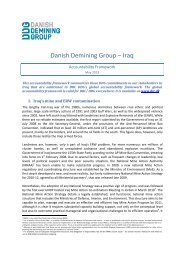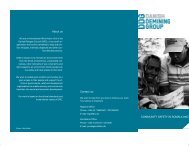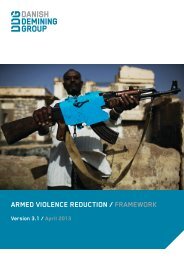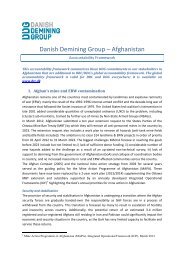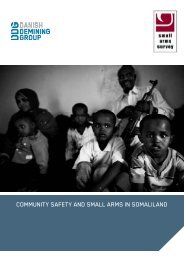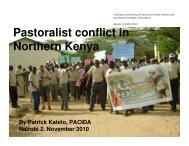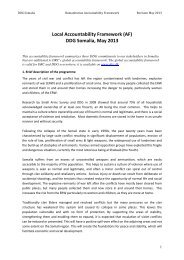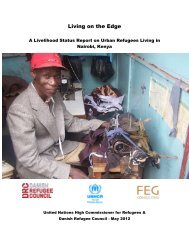Read the full report - Danish Refugee Council
Read the full report - Danish Refugee Council
Read the full report - Danish Refugee Council
You also want an ePaper? Increase the reach of your titles
YUMPU automatically turns print PDFs into web optimized ePapers that Google loves.
CASH PROGRAMME REVIEW FOR IDPs IN KABUL INFORMAL SETTLEMENTS 516. Securing cash distributionCash-based interventions in Afghanistan have mainly carried out distribution through fourmechanisms. This sub-section will provide an overview of <strong>the</strong> possible distribution mechanisms in<strong>the</strong> KIS, weighing <strong>the</strong>ir comparative advantages and disadvantages.Hawala: Most of <strong>the</strong> current cash-transfer programmes in Afghanistan have been donethrough <strong>the</strong> Hawala system 42 , perceived as efficient and more secure for <strong>the</strong> staff. Animportant step is to evaluate <strong>the</strong> capacity of Hawala traders on <strong>the</strong> field to provide for <strong>the</strong>amount of money. Whereas this may represent an issue in remote rural areas, <strong>the</strong> urbanenvironment of Kabul presents favourable conditions to <strong>the</strong> development of a Hawalasystem of distribution. In <strong>the</strong> light of evolution of security conditions, if staff security isconsidered a significant factor in transportation of money to <strong>the</strong> camps, Hawala transferscan <strong>the</strong>refore represent a practical option in <strong>the</strong> KIS. In safe contexts, however, itsadvantages are reduced and create unnecessary additional costs as opposed to directdistribution of cash. It must be underlined that transfer through Hawala does not dispenseagency from ensuring <strong>the</strong> presence of <strong>the</strong>ir staff to oversee distribution.ACF’s method for distributing cash through hawala:The distribution is planned in advance, setting <strong>the</strong> venue, identifying <strong>the</strong> number of staff to be presentto validate <strong>the</strong> money distribution. Prior to distribution, a cash distribution plan is elaborated,identifying <strong>the</strong> role of ACF, that of <strong>the</strong> hawala dealer, that of <strong>the</strong> government, <strong>the</strong> role of beneficiariesand CDCs. Nei<strong>the</strong>r <strong>the</strong> community nor <strong>the</strong> government representatives are informed of <strong>the</strong>distribution before <strong>the</strong> wake of <strong>the</strong> planned day for distribution. One day in advance, beneficiaries aregiven tickets mentioning <strong>the</strong>ir name, <strong>the</strong> amount of <strong>the</strong> transfer, <strong>the</strong> date and time of distribution.During distribution, <strong>the</strong> papers are checked for au<strong>the</strong>nticity, in presence of a community leader,signed and divided in two parts: one stays with <strong>the</strong> beneficiary, and <strong>the</strong> o<strong>the</strong>r is given to <strong>the</strong>hawaladar, to be counted and identified after distribution by ACF. Staff is present at a distance andgovernment representatives are not allowed inside a determined perimeter.Vouchers: A recent study by Samuel Hall for WFP underlined that “in several respectsvouchers have proven to be a more transparent means of transaction than cash since <strong>the</strong>yare used within a limited geographical population and only in designated retail outlets.However, as <strong>the</strong> voucher system expands it could present <strong>the</strong> same risks of susceptibility todiversions as cash, with counterfeiting becoming an additional threat” 43 . Setting up a vouchersystem requires pre-arrangements, to mitigate risks of misuse including <strong>the</strong> development ofa black-market or, including printing to avoid replication, and contracts with local tradersafter an initial survey assessing <strong>the</strong> storage capacity of <strong>the</strong> shop, <strong>the</strong> capacity of <strong>the</strong> trader torespond to <strong>the</strong> demand, and <strong>the</strong> location of <strong>the</strong> shop. Regular monitoring of shopkeepersshould fur<strong>the</strong>r be considered to ensure beneficiaries are not cheated on <strong>the</strong> amount of <strong>the</strong>voucher- a danger enhanced by high rates of illiteracy. Agreements with banks fur<strong>the</strong>r can besecured so that traders can redeem <strong>the</strong> vouchers received from beneficiaries, which is howWFP proceeded in Kabul. Alternatively, ACF’s staff distributed cash directly to <strong>the</strong>shopkeepers. In <strong>the</strong> case of <strong>the</strong> KIS, a food voucher system presents <strong>the</strong> direct advantage ofallowing people to address <strong>the</strong>ir food needs and increase dietary diversity. Lack ofdocumentation would however require <strong>the</strong> development of specific systems of identification.42 Hawala system is a traditional fund transferring system which widely used in Afghanistan, notably by Oxfam, PIN, UNICEFand ACF. (cf. Annex X)43 SAMUEL HALL CONSULTING (2013 upcoming), Cost of hunger study, Commissioned by WFP Afghanistan.



